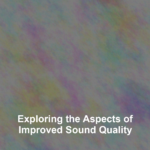When you select your equipment, set up your space, and fine-tune your techniques, youG??re laying the groundwork for superb sound quality. As an audiophile or audio professional, you know that the clarity of your audio can make or break the listenerG??s experience.
YouG??ve got to understand the nuances of sound fundamentals to discern what makes a recording truly stand out. Choosing the right equipment isnG??t just about the price tag; itG??s about knowing what serves your soundG??s unique character. And when it comes to room acoustics, a well-optimized space can be the difference between flat sound and audio that envelops the listener.
Mastery of recording techniques is crucial, but thereG??s an art to it that goes beyond the manuals. As for post-production and mixing, this is where your creative touch can transform good sound into something extraordinary. Embrace these elements, and youG??ll find yourself at the cusp of audio excellence, but thereG??s more to the story than just these components.
What lies beyond is a deeper understanding that could elevate your sound to new heights.
Understanding Sound Fundamentals
To truly enhance sound quality, itG??s essential to grasp the basics of how sound is produced and perceived. Imagine youG??re plucking a guitar string. It vibrates, creating waves that travel through the air. These are sound waves, and theyG??re what your ears pick up and your brain interprets as music.
Now, consider the room youG??re in. Its size, shape, and contents all affect how sound waves bounce around. Hard surfaces reflect sound, while soft materials absorb it. YouG??ve got to account for these elements when youG??re trying to optimize audio performance.
Your ears are pretty amazing, too. They can detect a wide range of frequencies, from the deep rumble of a bass drum to the high pitch of a whistle. But thereG??s more to it than just frequency. YouG??ve also got to think about amplitude, or loudness, and timbre, which is the quality that lets you tell a piano from a violin, even if theyG??re playing the same note.
Choosing the Right Equipment
Selecting equipment that complements your roomG??s acoustics and your listening preferences is key to superior sound quality. YouG??ve got to dive into the specs and understand which components work best for your space. Consider speaker size and type; large speakers arenG??t always the answer for small rooms, as they can overwhelm the space with bass. Conversely, small speakers mightnG??t do justice in a spacious area.
YouG??ll also want to look at amplifiers and receivers with enough power to drive your speakers efficiently, but not so much that youG??re overkilling it G?? balance is everything. Pay attention to the connectivity options too. Make sure theyG??re compatible with your existing devices, or youG??ll be in for a headache.
DonG??t forget cables and stands! High-quality cables can ensure minimal signal loss, and the right stands can eliminate unwanted vibrations. And while itG??s tempting to go for the flashiest gear, prioritize function over looks. YouG??re after sound quality, not just a pretty setup.
Lastly, read reviews and test out equipment when possible. What sounds good on paper doesnG??t always translate to your ears. Trust your instincts and youG??ll be on your way to an auditory experience thatG??s truly top-notch.
Room Acoustics Optimization
Once youG??ve chosen your equipment, itG??s crucial to fine-tune your roomG??s acoustics to maximize sound quality. The space youG??re in can significantly affect how you experience sound. YouG??ll want to tackle issues such as echo and reverberation, which can distort clarity and detail.
Start by analyzing your roomG??s shape and surfaces. Hard, flat areas like walls, ceilings, and floors reflect sound, which can create unwanted reverb. Combat this by adding soft materials like carpets, curtains, or acoustic panels to absorb excess sound. Pay special attention to the placement of your speakersG??ideally, they shouldnG??t be flush against walls or in corners where sound can bounce unpredictably.
Consider furniture placement as well. Heavy, plush items can absorb sound, reducing echo, while bookshelves can diffusely scatter sound waves, enhancing the richness of audio. DonG??t forget to experiment with speaker and seating positions to find the sweet spot where audio feels immersive and balanced.
Lastly, if youG??re serious about audio quality, look into specialized acoustic treatments like bass traps or diffusers. These can fine-tune your roomG??s sound profile, ensuring you get the most out of your listening experience.
Recording Techniques Mastery
How can you capture the essence of a live performance or the nuances of a vocal recording? Mastering the right techniques is essential. YouG??ve got to know your equipment inside out, from microphones to preamps, and how each component affects your sound. ItG??s not just about hitting G??recordG??; itG??s about understanding mic placement, polar patterns, and the environment youG??re recording in.
You should also grasp the importance of gain staging – setting the correct levels to avoid distortion or a too-quiet recording. ItG??s a balancing act that ensures clarity and dynamic range. DonG??t overlook the role of the performer, either. YouG??ll need to guide them to deliver their best performance, sometimes suggesting adjustments in their technique or positioning relative to the mic.
When it comes to mixing, you canG??t just slap on effects and call it a day. Learn how to use EQ, compression, and reverb effectively to enhance, not overwhelm, the source material. And remember, practice makes perfect. Keep experimenting with different techniques to find what works best for each situation. ThatG??s how youG??ll consistently produce recordings that sound professional and convey the intended emotion and energy.
Post-Production and Mixing
After youG??ve captured your raw audio, itG??s crucial to dive into post-production and mixing, where youG??ll shape and refine your tracks to perfection. At this stage, youG??re sculpting the final sound, and your decisions will significantly impact the quality of your project. ItG??s time to balance levels, pan instruments, and apply equalization (EQ) to ensure each element sits perfectly in the mix.
YouG??ll also work with dynamic range compression to maintain consistent volume and bring out subtleties in the performance. DonG??t forget about adding effects like reverb or delay, which can create depth and texture. However, itG??s critical to use effects judiciously; too much can muddy your sound.
Keep in mind that mixing is an art form. Trust your ears, but also take breaks to prevent fatigue and maintain perspective. Consider using reference tracks to compare your mix against professionally mixed works.
Conclusion
YouG??ve explored the essentials to elevate sound quality, from grasping sound fundamentals to mastering post-production.
Remember, the right gear is crucial, but itG??s your skill in recording and mixing thatG??ll truly refine those audio waves.
DonG??t overlook room acoustics; theyG??re key to pristine sound.
Keep honing your techniques, and youG??ll not only hear the differenceG??youG??ll feel it.
Now, go ahead, transform raw sounds into unforgettable auditory experiences with confidence and creativity.











